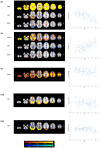Multimodal fusion analysis of functional, cerebrovascular and structural neuroimaging in healthy aging subjects
- PMID: 35855641
- PMCID: PMC9704789
- DOI: 10.1002/hbm.26025
Multimodal fusion analysis of functional, cerebrovascular and structural neuroimaging in healthy aging subjects
Abstract
Brain aging is a complex process that requires a multimodal approach. Neuroimaging can provide insights into brain morphology, functional organization, and vascular dynamics. However, most neuroimaging studies of aging have focused on each imaging modality separately, limiting the understanding of interrelations between processes identified by different modalities and their relevance to cognitive decline in aging. Here, we used a data-driven multimodal approach, linked independent component analysis (ICA), to jointly analyze magnetic resonance imaging (MRI) of grey matter volume, cerebrovascular, and functional network topographies in relation to measures of fluid intelligence. Neuroimaging and cognitive data from the Cambridge Centre for Ageing and Neuroscience study were used, with healthy participants aged 18-88 years (main dataset n = 215 and secondary dataset n = 433). Using linked ICA, functional network activities were characterized in independent components but not captured in the same component as structural and cerebrovascular patterns. Split-sample (n = 108/107) and out-of-sample (n = 433) validation analyses using linked ICA were also performed. Global grey matter volume with regional cerebrovascular changes and the right frontoparietal network activity were correlated with age-related and individual differences in fluid intelligence. This study presents the insights from linked ICA to bring together measurements from multiple imaging modalities, with independent and additive information. We propose that integrating multiple neuroimaging modalities allows better characterization of brain pattern variability and changes associated with healthy aging.
Keywords: fluid intelligence; healthy aging; linked independent component analysis; multimodal fusion; neuroimaging.
© 2022 The Authors. Human Brain Mapping published by Wiley Periodicals LLC.
Conflict of interest statement
No conflict of interest.
Figures







Similar articles
-
Specific patterns of brain alterations underlie distinct clinical profiles in Huntington's disease.Neuroimage Clin. 2019;23:101900. doi: 10.1016/j.nicl.2019.101900. Epub 2019 Jun 15. Neuroimage Clin. 2019. PMID: 31255947 Free PMC article.
-
Benefits of multi-modal fusion analysis on a large-scale dataset: life-span patterns of inter-subject variability in cortical morphometry and white matter microstructure.Neuroimage. 2012 Oct 15;63(1):365-80. doi: 10.1016/j.neuroimage.2012.06.038. Epub 2012 Jun 29. Neuroimage. 2012. PMID: 22750721
-
Predicting brain age with global-local attention network from multimodal neuroimaging data: Accuracy, generalizability, and behavioral associations.Comput Biol Med. 2025 Jan;184:109411. doi: 10.1016/j.compbiomed.2024.109411. Epub 2024 Nov 17. Comput Biol Med. 2025. PMID: 39556917
-
A meta-analysis and systematic review of single vs. multimodal neuroimaging techniques in the classification of psychosis.Mol Psychiatry. 2023 Aug;28(8):3278-3292. doi: 10.1038/s41380-023-02195-9. Epub 2023 Aug 10. Mol Psychiatry. 2023. PMID: 37563277 Free PMC article.
-
Multimodal Neuroimaging: Basic Concepts and Classification of Neuropsychiatric Diseases.Clin EEG Neurosci. 2019 Jan;50(1):20-33. doi: 10.1177/1550059418782093. Epub 2018 Jun 20. Clin EEG Neurosci. 2019. PMID: 29925268 Review.
Cited by
-
Functional magnetic resonance imaging study of group independent components underpinning item responses to paranoid-depressive scale.World J Clin Cases. 2023 Dec 26;11(36):8458-8474. doi: 10.12998/wjcc.v11.i36.8458. World J Clin Cases. 2023. PMID: 38188204 Free PMC article.
-
Associative memory is more strongly predicted by age-related differences in the prefrontal cortex than medial temporal lobes.Neuroimage Rep. 2023 Mar 23;3(2):100168. doi: 10.1016/j.ynirp.2023.100168. eCollection 2023 Jun. Neuroimage Rep. 2023. PMID: 40568457 Free PMC article.
-
Leveraging AI-Driven Neuroimaging Biomarkers for Early Detection and Social Function Prediction in Autism Spectrum Disorders: A Systematic Review.Healthcare (Basel). 2025 Jul 22;13(15):1776. doi: 10.3390/healthcare13151776. Healthcare (Basel). 2025. PMID: 40805809 Free PMC article. Review.
-
Hospitalisation for COVID-19 predicts long lasting cerebrovascular impairment: A prospective observational cohort study.Neuroimage Clin. 2022;36:103253. doi: 10.1016/j.nicl.2022.103253. Epub 2022 Nov 7. Neuroimage Clin. 2022. PMID: 36451358 Free PMC article.
-
Frontoparietal network integrity supports cognitive function in pre-symptomatic frontotemporal dementia: Multimodal analysis of brain function, structure, and perfusion.Alzheimers Dement. 2024 Dec;20(12):8576-8594. doi: 10.1002/alz.14299. Epub 2024 Oct 17. Alzheimers Dement. 2024. PMID: 39417382 Free PMC article.
References
-
- Alnæs, D. , Kaufmann, T. , Doan, N. T. , Córdova‐Palomera, A. , Wang, Y. , Bettella, F. , Moberget, T. , Andreassen, O. A. , & Westlye, L. T. (2018). Association of heritable cognitive ability and psychopathology with white matter properties in children and adolescents. JAMA Psychiatry, 75(3), 287–295. 10.1001/jamapsychiatry.2017.4277 - DOI - PMC - PubMed
-
- Azevedo, F. A. , Carvalho, L. R. , Grinberg, L. T. , Farfel, J. M. , Ferretti, R. E. , Leite, R. E. , Filho, W. J. , Lent, R. , & Herculano‐Houzel, S. (2009). Equal numbers of neuronal and nonneuronal cells make the human brain an isometrically scaled‐up primate brain. The Journal of Comparative Neurology, 513(5), 532–541. 10.1002/cne.21974 - DOI - PubMed
Publication types
MeSH terms
Grants and funding
- BRC-1215-20014/DH_/Department of Health/United Kingdom
- MC_UU_00030/14/MRC_/Medical Research Council/United Kingdom
- MR/M008983/1/MRC_/Medical Research Council/United Kingdom
- MR/J009482/1/MRC_/Medical Research Council/United Kingdom
- 103838/WT_/Wellcome Trust/United Kingdom
- MC_UU_00005/12/MRC_/Medical Research Council/United Kingdom
- SUAG/092 G116768/MRC_/Medical Research Council/United Kingdom
- SUAG/010 RG91365/MRC_/Medical Research Council/United Kingdom
- BB/H008217/1/BB_/Biotechnology and Biological Sciences Research Council/United Kingdom
- MC_U105597119/MRC_/Medical Research Council/United Kingdom
LinkOut - more resources
Full Text Sources
Miscellaneous

